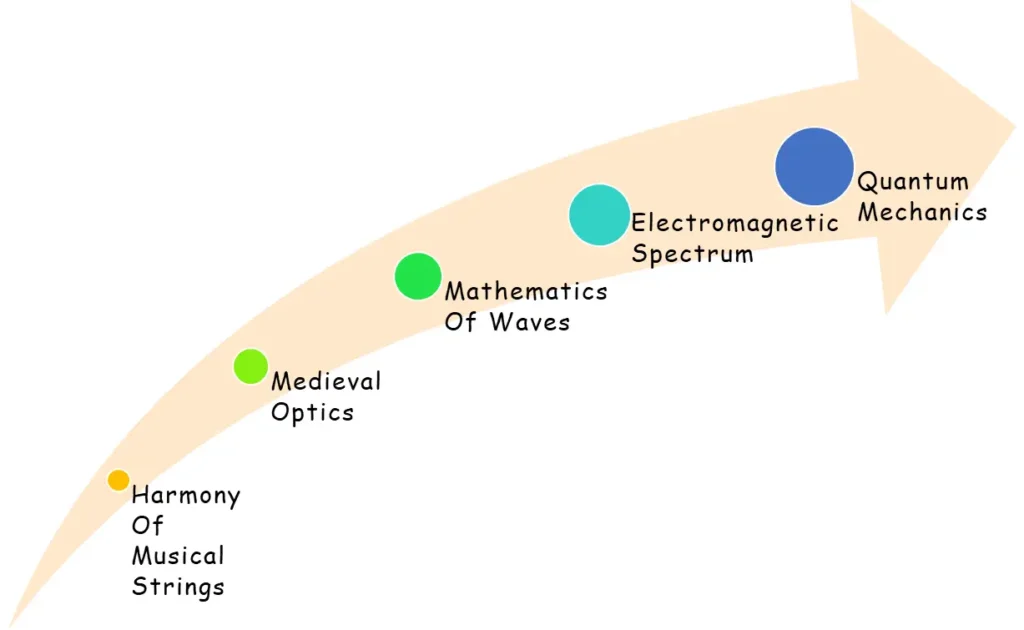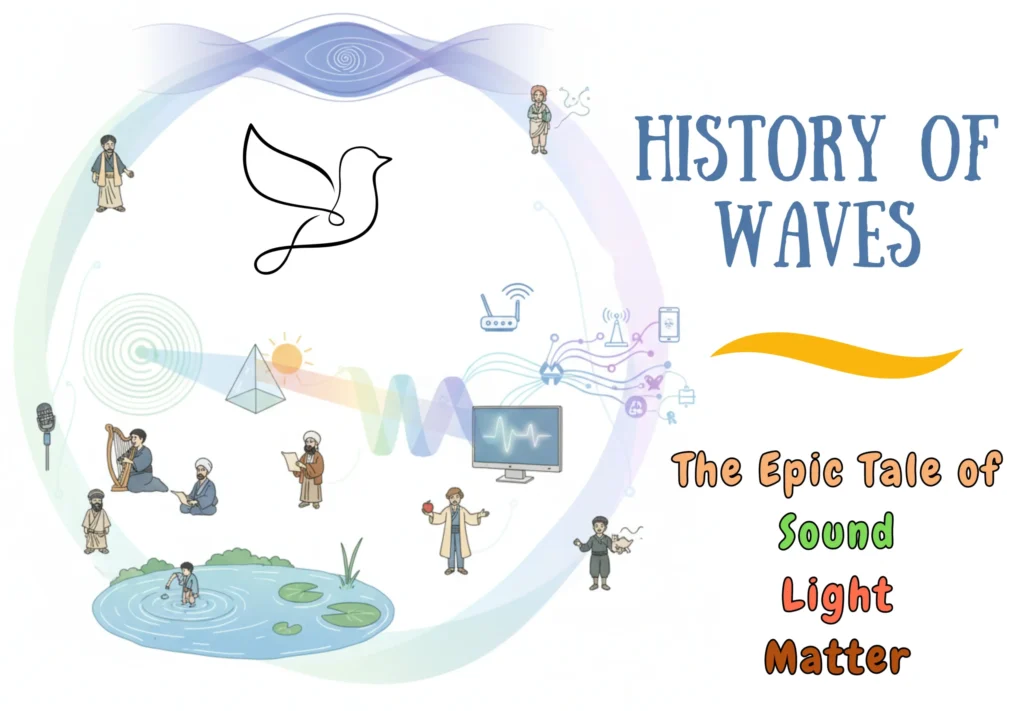“Why do waves matter?” From ripples in water and vibrating sounds to light, matter, and even space-time, the history of waves has shaped our understanding of the universe.
Table of Contents
Introduction
Waves are everywhere.
You can observe waves in the rippling of oceans, in the echoing of sounds in a theatre or auditorium, and even as light radiates through space. Today, we understand waves as carriers of energy and information. But for most of history, people saw waves — and even vision itself — in very different ways.
Ancient Greek thinkers, for example, proposed either emission theory or intromission theory.
The emission theory of sight stated that vision worked because the eyes sent out rays to objects. After all, if we look at something, it feels as though we project our gaze onto it — so it seemed natural to think of vision that way. The intromission theory, on the other hand, suggested that objects send tiny images into the eyes.
These competing views shaped centuries of debate until experiments finally resolved the question.
The Story of Waves
The idea of waves evolved slowly across cultures and eras. Its evolution follows the following trend:

Here, you will explore waves, seeing how humanity’s understanding of them changed step by step, and how those evolving beliefs set the stage for modern science.
1. Ancient Beginnings (6th – 4th Century BCE)
Early thinkers noticed patterns in nature and sound, hinting at invisible forces at work. Though primitive, these observations laid the groundwork for viewing motion and vibration mathematically.
Pythagoras and Musical Harmony
In the 6th century BCE, Pythagoras made a discovery that tied music to numbers. He showed that the pitch of a note depends on the length of a vibrating string: shorter strings produce higher tones, while longer ones create lower tones.
By studying ratios between string lengths, he revealed that harmony followed mathematical rules. This was a striking example of order hidden in sound.
Although Pythagoras never used the language of “waves,” his insights hinted at the deeper principle that vibration can be measured and predicted.
Pythagoras shifted music from an art of intuition into a science of proportion. In doing so, he planted one of the earliest seeds of wave theory, showing that invisible motions could be described through numbers.
Aristotle and Ripples in Water
Two centuries later, Aristotle extended such thinking to sound itself.
In the 4th century BCE, he compared sound to ripples moving across water. When an object vibrates, it pushes against the air, which in turn pushes the next layer, and so the disturbance spreads outward. His description framed sound as a physical motion that travels through a medium.
Aristotle’s analogy was not perfect, but it captured something essential:
“Waves transmit energy without carrying matter along with them”.
For instance, the water itself does not flow outward with ripples, and the air does not flow outward with sound — only the disturbance moves. This realisation became a cornerstone for later theories of mechanical waves.
2. Early Common Era (1st – 5th Century CE)
Roman architects experimented with sound subconsciously. They shaped the public spaces for optimal hearing. Their practical knowledge foreshadowed scientific principles like reflection, diffraction, and resonance.
Roman Architecture | An Epitome of Laboratory
The Romans’ amphitheatres were designed to carry the human voice to thousands of listeners. They demonstrated a practical grasp of sound behaviour. Builders positioned curved walls and seats to amplify voices without modern microphones.
The principles they applied in amphitheatres resemble what you today call reflection and diffraction. Their designs made sound a shared public experience, anchoring the role of acoustics in human gatherings.
3. Scholars of the Islamic Golden Age (8th – 15th Century)
During the Golden Age, scholars in the Islamic world advanced wave understanding with remarkable precision.
Notables from the Golden Age
Al-Kindi studied sound and resonance, describing how strings and air columns produce tones. Though he did not formally talk about resonance but he did lay the foundation of it.
Al-Farabi analysed musical instruments, explaining that vibrating bodies set the air into motion. He introduced the idea of sound as moving air, a crucial step toward modern wave theory.
Ibn Sina (Avicenna) went further. He described sound as a sequence of compressions and rarefactions in the air. This is almost exactly what we now call longitudinal waves. His insight bridged philosophy and physics.
He showed that sound was not just a phenomenon of harmony but a process of mechanical transmission. These contributions created a foundation that later European thinkers would build upon.
The Breakthrough of Optics (11th Century) | Ibn al-Haytham (Alhazen)
The greatest turning point in optics came with Ibn al-Haytham (Alhazen) in the 11th century. Until then, many thinkers still believed in emission theory, where the eyes sent out rays to touch objects. Ibn al-Haytham overturned this view.
Ibn al-Haytham argued that light travels from external sources, reflects off objects, and then enters the eyes. It was a refined form of the intromission theory whereby objects emit light.
In his Book of Optics, Ibn al-Haytham described reflection, refraction, and even the camera obscura. He showed through careful experiments that light travels in straight lines and bends when it passes into a new medium (just like diffraction).
By grounding optics in experiment rather than speculation, he broke from tradition. He even set the stage for the modern scientific method itself. His work became a cornerstone for later studies of both geometric and wave optics.
4. The Renaissance (16th – 17th Century)
Renaissance thinkers merged observation with measurement. They turned the qualitative ideas into quantifiable science. Experiments with light, motion, and vibration challenged old beliefs, setting the stage for modern physics.
Galileo and Vibrations
In the 16th century, Galileo Galilei turned his attention to vibrations.
Studying pendulums and musical strings, he observed how oscillations repeat in time. He noticed that these movements happen in a regular, repeating pattern – almost like a steady heartbeat. By timing pendulums, he could measure time very accurately.
These observations showed that vibrations have a rhythm, or frequency, which is an important idea for understanding waves. Galileo connected old ideas about music and harmony to precise experiments. He helped to make the study of waves more scientific.
Competing Theories of Light | Corpuscular Theory vs Wave Theory
The 17th century brought sharp debates about the nature of light.
Isaac Newton supported a particle theory. He suggested that light consisted of tiny corpuscles. His experiments with prisms revealed the spectrum of colours, but he explained it through particles rather than waves.
Christiaan Huygens, in contrast, put forward a wave theory of light in 1678. He argued that light spreads as spherical wavefronts, much like ripples on water. Huygens’ Principle explained reflection and refraction more naturally than Newton’s model.
The clash between particle and wave theories shaped scientific debates for centuries, highlighting the complexity of understanding light.
5. The Mathematical Century (18th Century)
In the 1700s, mathematicians began describing waves using equations instead of just words or pictures. This lets them predict how waves move precisely.
Euler & d’Alembert
Leonhard Euler and Jean le Rond d’Alembert studied vibrating strings, like those on a musical instrument. They came up with a formula called the wave equation:
![]()
Here:
 is the displacement of the string at position
is the displacement of the string at position  and time
and time 
 is the speed of the wave along the string
is the speed of the wave along the string
This equation shows that vibrations move through space and time in a predictable way.
Daniel Bernoulli
Bernoulli showed that complicated vibrations could be broken into simpler sine waves. Any vibration could be written as:
![]()
Here:
 is the amplitude of each “harmonic” (a full standing-wave pattern, including crests and troughs)
is the amplitude of each “harmonic” (a full standing-wave pattern, including crests and troughs) is the length of the string
is the length of the string is the frequency of each harmonic
is the frequency of each harmonic
This means that even complex motions are made of simple waves added together.
With these contributions, waves moved from analogy into rigorous calculation, ready to be tested and expanded in the 19th century with experiments on light and electromagnetism.
6. The Century of Light and Electromagnetism (19th Century)
In the 19th century, waves were no longer just phenomena; they became fundamental to understanding the universe itself. Experiments confirmed the wave nature of light, while electricity and magnetism revealed deeper connections.
Young and Interference
In 1801, Thomas Young performed his famous double-slit experiment. By shining light through two narrow openings, he produced bright and dark fringes on a screen. This pattern revealed interference — proof that light behaves like a wave, since only waves can combine to reinforce or cancel each other.
Young’s experiment was decisive. It showed that light could not be explained solely by Newton’s corpuscles. The wave model gained ground, offering a clearer account of phenomena like colour and diffraction.
Fresnel and Diffraction
In the following decades, Augustin-Jean Fresnel expanded the wave theory of light. He explained diffraction, the bending of waves around obstacles and through small openings. Fresnel combined mathematics with careful experiments, producing results that matched observations with stunning accuracy.
Together, Young and Fresnel made the wave theory dominant. Their work demonstrated that light, like sound, obeyed the principles of superposition and interference. This opened the door to treating light as part of a larger family of wave phenomena.
Faraday, Maxwell, and Electromagnetic Waves
While Young and Fresnel focused on light, Michael Faraday explored electricity and magnetism.
He discovered that electric and magnetic forces influence each other. His findings inspired James Clerk Maxwell, who in the 1860s wrote down four equations that unified electricity, magnetism, and light.
Maxwell’s equations can be written as:
![]()
![]()
![]()
![]()
Here:
 is the electric field
is the electric field is the magnetic field
is the magnetic field is the charge density
is the charge density is the current density
is the current density is the permittivity of free space
is the permittivity of free space is the permeability of free space
is the permeability of free space
From these equations, Maxwell predicted that electromagnetic disturbances travel as waves with a speed:
![]()
When he calculated this speed, it matched the known speed of light (about ![]() . This showed that light itself is an electromagnetic wave.
. This showed that light itself is an electromagnetic wave.
This breakthrough transformed science. It revealed that visible light was just one slice of a vast spectrum, ranging from radio waves to gamma rays. The wave theory had expanded beyond sound and water to encompass the very fabric of energy in the universe.
7. Waves in the Quantum and Modern Era (20th – 21st Century)
Modern science connects waves in technology, medicine, and even the fabric of space-time itself. Quantum discoveries showed that waves and particles are two sides of the same coin.
The 20th century brought a surprising twist: light, once firmly established as a wave, also behaved like a particle.
Wave–Particle Duality
Max Planck and Albert Einstein showed that light is made of small packets of energy called quanta, or photons. Experiments revealed that light can behave both like a wave and like a particle. This dual behaviour is called wave–particle duality. This idea revolutionised the way scientists thought about the nature of light.
In 1924, Louis de Broglie proposed another revolutionary idea:
If light can behave like both a wave and a particle, then perhaps particles of matter, such as electrons, could also have wave-like properties.
This meant that matter could show phenomena like interference and diffraction, which were previously thought to occur only with waves.
Wave Mechanics
A few years later, Erwin Schrödinger built on de Broglie’s insight. He developed wave mechanics. This can be defined as:
“A framework that treats particles as waves and calculates probabilities, not definite paths.”
It was a mathematical framework that described particles as wave functions that evolve. These wave functions allowed scientists not to treat particles as a single fixed point but to calculate the probabilities of where a particle might be found.
These breakthroughs show that waves are not just a property of sound or light. They form a fundamental part of all physics. They provide a unified way to understand both matter and energy at the microscopic level.
Modern Applications and Discoveries
Once the wave concept was fully understood, it quickly led to new technologies.
During World War II, radar used waves to guide ships and airplanes. Later, lasers and fibre optics enabled high-speed communication. Waves became powerful tools in medicine. They allow technologies such as ultrasound and MRI to explore the body safely, painlessly, and without cutting into it.
In 2015, scientists detected gravitational waves. These are tiny ripples in space-time predicted by Einstein a century earlier. This discovery linked waves to the deepest laws of the universe. It showed that wave phenomena are not just laboratory curiosities but a fundamental feature of reality.
Why do Waves Matter? | The History of Waves
Waves shape almost every part of our daily lives, often in ways we do not notice. Across history, humanity’s growing understanding of waves has transformed science, technology, and culture.
- Sound waves let us communicate, enjoy music, and stay aware of our surroundings.
- Light waves allow us to see, power photography, and enable screens and cameras that connect us to the world.
- Electromagnetic waves, though invisible, carry signals for Wi-Fi, radios, and mobile phones.
- Medical waves, like ultrasound and MRI, help doctors diagnose conditions and explore the body safely.
From ripples in a pond to gravitational waves traveling across the cosmos, waves transmit energy and information. They make modern life possible and expand our understanding of the universe.
Conclusion
The story of waves is the story of human curiosity. From Pythagoras’ strings to Ibn al-Haytham’s optics, from Young’s interference to Maxwell’s electromagnetic theory, each step revealed a new dimension. This brightens our understanding of how the universe carries energy and information.
What began as analogies of ripples and harmony grew into equations, experiments, and technologies. Waves are no longer just disturbances in air or water. They are a unifying language of science. They link sound, light, matter, and even space-time itself.
Frequently Asked Questions (FAQs)
Who is the father of modern optics?
Ibn al-Haytham (Alhazen) is the father of modern optics. He proved that light travels from objects to the eye and explained reflection, refraction, and vision through experiments.
Who is the father of wave theory?
Christiaan Huygens is the father of wave theory, proposing that light spreads as waves and explaining reflection, refraction, and diffraction.
Who proposed the Corpuscle Theory and Wave Theory of light?
Isaac Newton proposed the Corpuscular (particle) Theory of light, suggesting light is made of tiny particles.
Christiaan Huygens proposed the Wave Theory of light, showing that light spreads as waves and explaining reflection, refraction, and diffraction.
Who first described sound as compressions in air?
Ibn Sina (Avicenna) described sound as a sequence of compressions and rarefactions, laying the foundation for understanding longitudinal waves.
Who proved that light exhibits interference patterns?
Thomas Young proved light behaves like a wave using his double-slit experiment, showing bright and dark interference fringes.
Who unified electricity, magnetism, and light as electromagnetic waves?
James Clerk Maxwell unified these forces through Maxwell’s equations, predicting that electromagnetic waves travel at the speed of light.
Who introduced wave–particle duality?
Max Planck and Albert Einstein introduced wave–particle duality, showing that light behaves as both waves and photons.
Who proposed that matter can behave as waves?
Louis de Broglie proposed that particles like electrons exhibit wave-like properties, leading to the matter-wave theory.
Who developed wave mechanics in quantum physics?
Erwin Schrödinger developed wave mechanics, describing particles as evolving wave functions rather than fixed points.
Who first detected gravitational waves?
The LIGO Scientific Collaboration first detected gravitational waves in 2015, confirming Einstein’s predictions about ripples in space-time.

